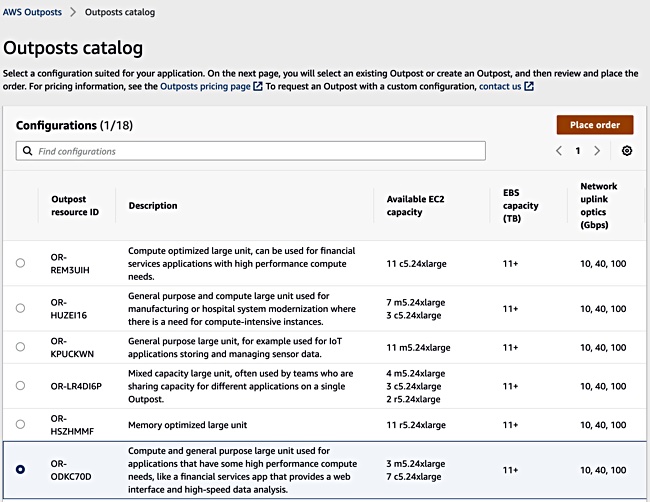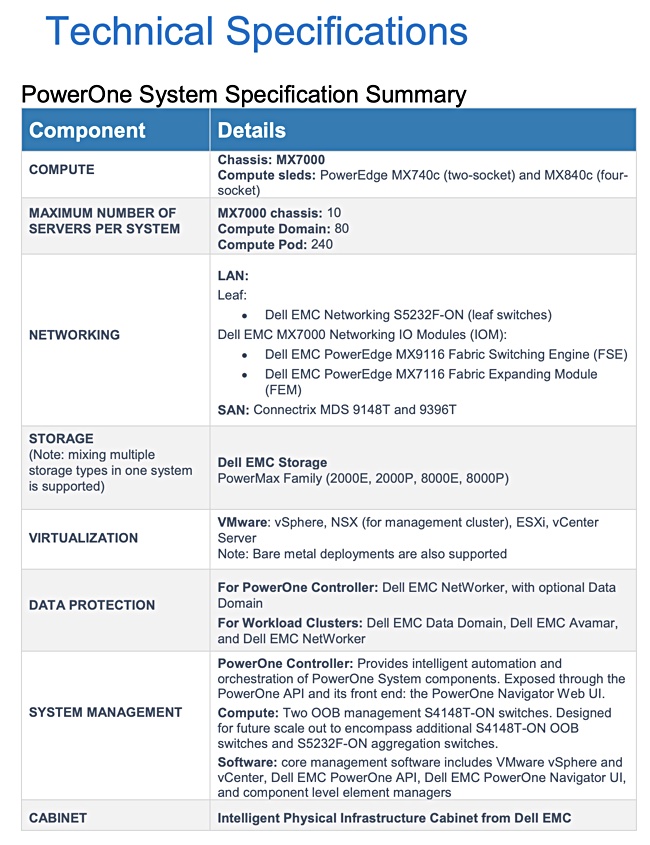AWS Outposts is a converged infrastructure rack, announced at re:Invent in Las Vegas this week. In effect this is Amazon’s public cloud in a box, delivering an all-AWS hybrid computing environment within the customer’s data centre.
By coupling Outposts so tightly to AWS, Amazon is taking a different approach than other converged infrastructure rack vendors such as Dell EMC.
AWS Outposts is a fully-managed compute, networking and storage rack built with AWS-designed hardware that allow customers to run AWS services on-premises or in co-location sites and is connected to the AWS public cloud.

An Outpost rack is conceptually equivalent to a converged infrastructure (CI) rack such as Dell EMC’s PowerONE and VxBlock systems.
The Outposts rack contains servers, storage, AWS software, redundant power supplies and built-in top-of-rack network switches. The switch supports 1/10/40/100 Gbit/s uplinks. There are Outposts compute and storage capacity options. Customers can also work with Amazon to create a custom combination with their desired EC2 and EBS capacity. This combo is pre-tested and validated by Amazon before delivery.
An AWS Outposts FAQ states: “AWS Outposts leverages AWS designed infrastructure, and is only supported on AWS-designed hardware.” For example, EBS snapshots created on an Outposts rack are stored in the connected region’s S3 vault.
The Outposts rack must be connected across the public internet to a parent AWS region with a high-availability link. AWS uploads and executes software upgrades and patches across this link.
Configurations
Outposts racks are configured by available EC2 and EBS capacities. For example: Compute optimised – 11 c5.24xlarge EC2 capacity and 11+ TB of EBS capacity. There are options for memory optimised, graphics large units, general purpose units. Here is a sample from a trial configuration process.

There is no option to select specific server CPU models with their cores and clock rating. You cannot specify the amount of memory nor the amount and type of storage media. We saw no option to specify particular software or Amazon services.
Prices lists EBS storage tiers – 2.7TB, 11TB, 33TB and 55TB – with per GB/month prices ranging from $0.25 to $0.55.
Customers can pay all upfront, make a partial upfront payment or pay through monthly subscription. For example, an OR-FWTFFXJ compute-optimised unit with a three-year term costs $239,761.41 upfront, $123.650.18 partial upfront payment and $3,434.73 monthly or $7,148.67 monthly.
The most costly Outposts rack, an OR-HSZHMMF memory-optimised large unit, costs $1,079,998.31 upfront or $33,869.12 per month.
These prices do not include operating system usage, which is charged by the second per instance.
AWS Services on Outposts are priced based on usage by the hour per instance and excludes underlying EC2 instance and EBS storage charges. Available AWS services include RDS, ECS, EKS, EMR and App Mesh and their prices are explained in their service web pages. For example, this is the EKS pricing page.
VMware intends to launch VMware Cloud on AWS Outposts next year so users can have VMware on their own in-premises gear, in the AWS public cloud and on the Outposts rack.
Cohesity, Druva and Veritas have each announced that their protection products support AWS Outposts.
Let’s now explore how AWS Outposts differs from Dell EMC’s PowerOne and VxBlock CI systems.
Dell EMC PowerOne and VxBlock
PowerOne is a converged infrastructure system comprising compute, storage, networking, VMware virtualization software, and data protection in a single rack. All components come from Dell Technologies. The technical specifications list the components in each category:

The customer has to understand their workload and what it needs in terms of compute, storage, networking and protection capacity. On delivery it has to be set up and an automation engine helps with this and with provisioning resources for application workloads.
The PowerOne selection language is different from that of AWS Outposts which is specified in terms of EC2 instance types and EBS capacity.
Dell EMC’s VxBlocks are also specified by components and use Dell EMC storage, VMware virtualization software and Cisco servers and networking.
Customers can run a VMware environment in Amazon but there is no easy way to port VxBlock applications to run in AWS. Typically, VxBlock hybrid cloud entails backing up VxBlock data to AWS, not application portability.
When – or if – VMware Cloud Foundation runs on VxBlock and PowerOne we can look forward to an all-VMware hybrid cloud that embraces CI systems from Dell EMC and AWS Outposts.
Pricing for PowerOne and VxBlocks is not publicly available.
This way to the hybrid cloud
Ideally a hybrid on-premises public cloud environment would have a simpler management plane and application portability between the on-premises and public cloud systems.
AWS Outposts enables customers to run an all-Amazon hybrid cloud with Outposts on-premises linking to the AWS public cloud under a single AWS management facility.
Amazon sees hybrid cloud as the AWS public cloud connected to AWS Outposts.
Dell EMC envisages the hybrid cloud as its on-premises infrastructure extended out and linked to multiple clouds, for backup or storage tiering, for example. Customers should be able to run virtual machines that run on-premises in the public cloud and also containers.
With this model, the on-premises supplier calls the shots and helps itself and its customers to avoid cloud lock-in.
By contrast, AWS Outposts shows Amazon constructing the hybrid cloud as an entirely in-house affair with a unified on-premises and public cloud AWS environment managed from AWS. With the notable exception of VMware Cloud Foundation, this vision does not accommodate third party vendors or integrate with non-Amazon environments. At least, not at the moment.







